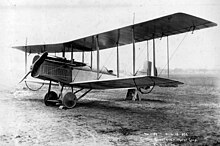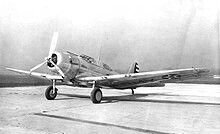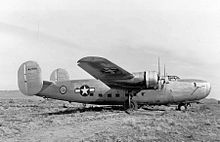For other uses, see 7th Reconnaissance Squadron.
| 397th Bombardment Squadron 7th Reconnaissance Squadron | |
|---|---|
 RQ-4 Global Hawk Block 40 at Sigonella RQ-4 Global Hawk Block 40 at Sigonella | |
| Active | 1917–1946; 2015–present |
| Country | |
| Branch | |
| Role | Reconnaissance |
| Part of | Air Force Combat Command |
| Garrison/HQ | Naval Air Station Sigonella |
| Engagements | American Antisubmarine Theater |
| Insignia | |
| 7th Reconnaissance Squadron emblem |  |
| 397th Bombardment Squadron emblem (approved 5 May 1924) |  |
The 7th Reconnaissance Squadron is a squadron of the United States Air Force. It is assigned to the 319th Operations Group and is stationed at Naval Air Station Sigonella, Sicily, Italy.
The squadron was first established in the Panama Canal Zone as the 7th Aero Squadron in 1917 and served as a reconnaissance unit until 1942, when it was redesignated as the 397th Bombardment Squadron. It served as a bomber unit through World War II and was inactivated at Rio Hato Army Air Base, Panama on 1 November 1946. The squadron was reactivated in 2015, returning to its earlier reconnaissance mission.
History
| This section needs additional citations for verification. Please help improve this article by adding citations to reliable sources in this section. Unsourced material may be challenged and removed. (July 2015) (Learn how and when to remove this message) |
The squadron's mission from its inception in 1917 to its inactivation in 1946 was the defense of the Panama Canal. During the 1920s and 1930s it participated in a number of goodwill missions to nations in Central and South America. From its origins in 1917 until 1942, the unit was designated a variation of the 7th Reconnaissance Squadron.
World War I

With the entry of the United States into World War I, the War Department believed it was necessary to establish an air presence along the Atlantic terminus of the Panama Canal as a defensive measure against an enemy seaborne attack.
In advancing its plans for the defense of the Atlantic and Gulf coasts of the United States, the joint Army-Navy board recommended the establishment of eight aeronautic stations which, with a strength of two dirigibles and six or eight seaplanes each, could immediately conduct patrol work. Significantly, the only site definitely advanced as vital in the overall plan was that at the Coco Solo United States Navy submarine base near Colón in the Canal Zone.
The Army selected Captain Henry H. Arnold, then in training at the Army Aviation School at Rockwell Field, near San Diego, to proceed immediately to the Canal Zone and form and command an aviation squadron there. This unit was designated the 7th Aero Squadron and was organized on 29 March 1917. Captain Arnold did not remain long with the 7th Aero Squadron, however, as he returned to the United States in April 1917. The squadron personnel arrived for duty in the Canal Zone with 51 officers and enlisted men. Initially garrisoned at Ancón, Canal Zone at the end of March 1917, the unit moved to Corozal by 16 April. They then moved to the large temporary camp at Empire, Canal Zone in May, all on the Pacific side of the isthmus – not making the move to Fort Sherman's parade field until around 29 August 1917, on the Atlantic side. The unit did not receive its first aircraft until about 10 December 1917, when two Curtiss R-4's were tested at Fort Sherman. These were followed by Curtiss R-6's on 12 February 1918 which were supplied by the Navy. Besides its Curtiss R-4's and R-6's, the unit also had two Curtiss R-3's which, oddly, had arrived after the R-4's, in late December 1917.
With the end of World War I most of the 7th Aero Squadron's personnel were transferred back to the United States for demobilization.
Between the wars



After the war, the squadron evolved into the 7th Squadron (14 March 1921), 7th Observation Squadron (25 January 1925), 7th Reconnaissance Squadron (1 September 1937), 7th Reconnaissance Squadron (Medium Range) (6 December 1939) and 7th Reconnaissance Squadron (Heavy) (20 November 1940) before being finally redesignated as the 397th Bombardment Squadron (Heavy) on 22 April 1942. The squadron was assigned to the 6th Composite Group.
After World War I, the squadron is credited with having operated numerous aircraft types between 1919 and 1931. These included, the venerable U.S.-built Dayton-Wright DH-4 series of light bomber/general purpose aircraft; the Curtiss JN-4 "Jenny" family of trainers; the Loening OA-1 amphibians, these being uniquely suited to conditions in Panama, Douglas O-2 observation aircraft and, surprisingly, Curtiss HS-1 and HS-2L flying boats. Of the DH-4's, the first six postwar examples, all virtually stock DH-4B's, arrived for duty with the 7th in February 1920, replacing the well-worn Curtiss R-6's and other earlier DH-4's. By 16 February 1922, the squadron had seven "war-built" DH-4's, four DH-4B's, the solitary Curtiss JN-4H, three Curtiss JN-6's. By August, all but one of the "war-built" DH-4's had been scrapped and one of the DH-4B's had been converted to DH-4BP-1 (photographic) configuration.
By June 1927, the squadron, now in a very lean peacetime stance, had but eight aircraft. These consisted of four DH-4M's, a solitary DH-4B, a Loening OA-1 and two Loening OA-1As.
In 1937, the 6th Group, which had been a composite unit since its establishment in 1919, became the 6th Bombardment Group. The squadron was equipped with Douglas B-18 Bolos, although a single Northrop A-17 Nomad was also assigned for a period, together with a Sikorsky OA-8.
By 1 February 1940, the assignment to the 6th Bombardment Group was changed to an attachment, as the unit was reassigned to the 19th Composite Wing and placed under the control of the Caribbean Air Force staff as one of the dedicated reconnaissance elements reporting to that headquarters. On 4 June 1941, it was assigned one Boeing B-17B Flying Fortress, the first production version of the Flying Fortress, which had been transferred to the command. Obsolete as a bomber, the mission of the B-17B was long-range reconnaissance in the Canal Zone, although the aircraft retained its defensive machine guns for defense against any enemy aircraft it may encounter On 8 October 1941, it was once again assigned to the 6th Bombardment Group and, on 27 November, the unit moved from France Field to the newly constructed Howard Field on the Pacific side, where it received four additional B-17Bs.
World War II


After the Japanese Attack on Pearl Harbor the Squadron was almost immediately deployed to David Field, Panama. The Squadron's B-17 Flying Fortress aircraft deployed elsewhere (mainly to Guatemala City Airport) to begin the Pacific patrols in early January 1942. The squadron was redesignated as the 397th Bombardment Squadron (Heavy) effective 22 April 1942.
The return to David Field came just in time for deployment of the unit as a whole from David to Talara Airfield, Peru, where it arrived on 18 August. From there the squadron undertook the Pacific patrol arc out to Seymour Airport in the Galápagos Islands and, sometimes, on to Guatemala City Airport. These flights continued, almost non-stop, through May 1943, when the unit was relieved and returned to Río Hato Field in Panama. The LB-30s retained their original British serial numbers throughout their service with the squadron. Upon its return to Rio Hato on 4 May 1943, the 397th was transformed, as an entirely new cadre of personnel replaced the veterans of the Galapagos and earlier tours there. Three days later, the Squadron moved to Howard Field in the Canal Zone, although this was apparently a mere paper move of its headquarters, as the unit's aircraft and personnel actually remained at Rio Hato.
On 1 January 1944, the squadron received orders to deploy four of its LB-30s to France Field to participate in the search for several marauding German U-boats which were causing considerable alarm in the Caribbean. While at France Field, the aircraft also flew navigational and bombing exercises.
All of this was preparatory to the unit's deployment to the Galapagos Islands and, starting 7 April 1944, the ground echelon started movement to Balboa, Canal Zone, via truck for the transfer. The air element got four more B-24J's on 8 April and, with these, flew with the earlier two B-24J's and two B-24D's to Seymour Field in the Galapagos. Other missions, besides the normal long-distance patrols, saw 397th aircraft operating to Salinas Airport, Ecuador; Havana Airport, Cuba; Borinquen Field, Puerto Rico; Managua Airport, Nicaragua; Cartagena airport, Colombia and elsewhere throughout Central and South America.
In February 1945, the unit was relieved from duty in the Galapagos and returned to Rio Hato, where the unit ended the war, on 1 November 1946 when it was inactivated.
Reactivation in 2015
On 1 May 2015, the unit was redesignated 7th Reconnaissance Squadron. It was reactivated at Naval Air Station Sigonella, Sicily, Italy on 15 May, where it replaced Detachment 1, 69th Reconnaissance Group. Initially assigned to the 69th Group, it is currently assigned to the 319th Operations Group at Grand Forks Air Force Base, North Dakota.
Lineage
- Organized as 7th Aero Squadron on 29 March 1917
- Redesignated: 7th Squadron on 14 March 1921
- Redesignated: 7th Observation Squadron on 25 January 1925
- Redesignated: 7th Reconnaissance Squadron on 1 September 1937
- Redesignated: 7th Reconnaissance Squadron (Medium Range) on 6 December 1939
- Redesignated: 7th Reconnaissance Squadron (Heavy) on 20 November 1940
- Redesignated: 397th Bombardment Squadron (Heavy) on 11 May 1942
- Redesignated: 397th Bombardment Squadron, Heavy c. 1944
- Inactivated on 1 November 1946
- Redesignated 7th Reconnaissance Squadron on 1 May 2015
- Activated on 15 May 2015
Assignments
- Panama Canal Department, 29 March 1917
- 3d Observation Group (later 6th Observation Group, 6th Composite Group, 6th Bombardment Group), 30 September 1919
- 19th Composite Wing, 1 February 1940 (attached to 6th Bombardment Group)
- 6th Bombardment Group, 25 February 1942
- VI Bomber Command, 1 November 1943 – 1 November 1946
- 69th Reconnaissance Group, 15 May 2015 – June 2019
- 319th Operations Group
Stations
- Ancon, Panama Canal Zone, 29 March 1917
- Corozal, Panama Canal Zone, 16 April 1917
- Empire, Panama Canal Zone, May 1917
- Fort Sherman, Panama Canal Zone, c. 29 August 1917
- Cristobal, Panama Canal Zone, March 1918
- Coco Walk (later France Field), Panama Canal Zone, May 1918
- Howard Field, Panama Canal Zone, 26 November 1941
- David Field, Panama, 11 December 1941
- Talara Airfield, Peru, 18 August 1942
- Rio Hato Army Air Base, Panama, c. 4 May 1943
- Seymour Island Army Airfield, Baltra, Galapagos Islands, c. 7 April 1944
- Rio Hato Army Air Base, Panama, c. 6 February 1945 – 1 November 1946
- Naval Air Station Sigonella, 15 May 2015 – present
Aircraft
- Curtiss R-4, 1917–1919
- Curtiss R-3, 1917–1919
- Curtiss R-6, 1918–1919
- Curtiss R-9, 1918–1919
- Curtiss JN-4, 1918–1919, 1919–1920
- Curtiss JN-6, 1919–1920
- Dayton-Wright DH-4, 1919–1931
- Curtiss HS-2L, 1919–1931
- Loening 0A-1, 1927–1931
- Douglas 0–2, 1919–1931
- Thomas Morse 0–19, 1930–1937
- Douglas OA-4 Dolphin, 1930–1936
- Martin B-10, 1936–1939
- Douglas B-18 Bolo, 1938–1942
- Boeing B-17 Flying Fortress, 1941–1942
- Consolidated LB-30 Liberator, 1942–1944
- Northrop A-17A Nomad, 1943
- Consolidated B-24 Liberator, 1943–1946
- Northrop Grumman RQ-4 Global Hawk, 2015–present
See also
References
- Notes
- On a blue diamond piped with red with its long axis horizontal a white sword pointing to the dexter behind a white shield displaying a black portcullis.
- Citations
- ^ Maurer, Combat Squadrons, pp. 486–487
- Maurer, Combat Units, pp. 41–43
- Miller, Kevin (18 August 2015). "Air Force Report: 7th Reconnaissance Squadron". Defense Video Imagery Distribution System. Retrieved 3 August 2016.
- Robertson, Patsy (9 April 2012). "Factsheet 69 Reconnaissance Group (ACC)". Air Force Historical Research Agency. Archived from the original on 27 September 2015. Retrieved 16 January 2013.
- ^ Haulman, Daniel L. (29 May 2015). "7 Reconnaissance Squadron (ACC)". Air Force Historical Research Agency. Retrieved 1 October 2017.
- ^ "319th Operations Support Squadron". grandforks.af.mil. Retrieved 29 September 2023.
- ^ Conaway, William. "397th Bombardment Squadron (Heavy)". VI Bomber Command in Defense of the Panama Canal 1941 – 45.
- Tiggs, SRA Elijaih. "319th Air Base Wing Redesignates as 319th Reconnaissance Wing". Grand Forks Air Force Base. 319th Reconnaissance Wing Public Affairs. Retrieved 29 June 2019.
Bibliography
![]() This article incorporates public domain material from the Air Force Historical Research Agency
This article incorporates public domain material from the Air Force Historical Research Agency
- Conaway, William. "VI Bomber Command In Defense Of The Panama Canal 1941 – 45". Planes and Pilots of World War Two.
- Maurer, Maurer, ed. (1982) . Combat Squadrons of the Air Force, World War II (PDF) (reprint ed.). Washington, DC: Office of Air Force History. ISBN 0-405-12194-6. LCCN 70605402. OCLC 72556.
- Further reading
- Hagdedorn, Dan (1995), Alae Supra Canalem: Wings Over the Canal, Turner Publishing, ISBN 1563111535
- Maurer, Maurer (1987). Aviation in the U.S. Army, 1919-1939 (PDF). Washington, DC: Office of Air Force History, United States Air Force. ISBN 0-912799-38-2. LCCN 87012257. OCLC 15661556. Retrieved 20 July 2013.
External links
- AFHRA Document 00202312 6th Bomber Command 1912-1941
- AFHRA Document 00899478 USAF Southern Command History, 1920–1975
- AFHRA Document 00046226 397th Bombardment Squadron History, 1939–1941
- AFHRA Document 00046227 397th Bombardment Squadron History, 1941–1942
| Previously: Panama Canal Air Force (1940-1941); Caribbean Air Force (1941-1942) | |||||||||||||||
| Airfields |
|  | |||||||||||||
| Units |
| ||||||||||||||
| |||||||||||||||